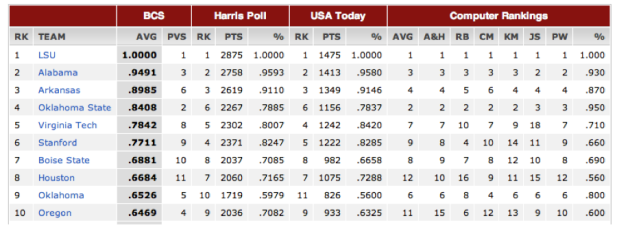[Cross blogged for Leland Quarterly]
When I was looking for the metaphor to describe this week’s game, I went through a lot of options. Stanford’s prowess in logical reason and philosophical debate definitely lent itself towards the idea of duck season. The pomp rapidly expanding around the game reminded me of Duck Soup. Hell, I even thought the idea of two top-ten teams warranted a Clash of the Titans reference (Andrew Luck would be, of course, the Kraken).
Yet they all lacked that certain something that defined the match up this weekend, mighty Oregon versus fearsome Stanford. And then something wonderful happened: Joe Frazier passed away.
This is, objectively and obviously, a terrible thing. Smokin’ Joe was a phenomenal boxer and athlete, graced with the coveted undisputed-heavyweight-champion-of-the-world title for several years until he lost it in a terrific battle with a man named after a fat-draining hamburger grill. But the death of this icon reminded me of his most iconic fight: the Fight of the Century between Frazier and another boxer named Muhammad Ali (maybe you’ve heard of him).
There, at last, was the metaphor. Frazier walked into that fight with a record of 26 wins (23 by knock out) to 0 losses; Ali had 31 wins (25 KOs) and 0 losses. Stanford walks into our fight on Saturday with 17 straight wins (3 shutouts) and 0 losses in a over a year; Oregon has 18 straight conference wins (2 shutouts) and 0 conference losses in two years.
Buckle your seatbelts. We’re in for the Pac-12 Game of the Century.

Our mouth guards are better, though.
The Fight of the Century lived up to its hype. When the dust (and blood and sweat and spit and whatever else gets sprayed into the ring) settled after fifteen grueling rounds, Muhammad Ali had lost for the first time in his professional career. The Greatest was now second best. And suddenly, Frazier was king of the world.
If Stanford finds itself standing over Oregon at the end of the bout, we’re suddenly king of the world. The trick, however, is to make it all fifteen rounds. That’s what makes a good fight into a great fight—and what makes a Stanford-Oregon football game into the Stanford-Oregon football game.
Such a historic game mandates historic Stanford football fervor. Luckily, most of this fight’s promoting has already been done for us. For the first time in Stanford’s history, ESPN’s preeminent college football program, College Gameday, is coming to campus. The nation is watching. There are Pac-12 championship and—dare I say—national title implications.

PARTY WITH LELAND CORSO
So we don’t really need a promoter, but what would any boxing match be without one? Allow me to put on my Don King hat/wig for a minute.

It’s pretty similar to my crazy homeless person hat/wig.
Ahem.
LADIES AND GENTLEFOLK:
WELCOME TO THE GAME OF THE CENTURY. PLEASE DIRECT YOUR ATTENTION TO THE RING, WHERE I PRESENT TO YOU TODAY’S FIGHTERS, THOSE COLOSSAL COLLEGIATE COMBATANTS, THE PUGNACIOUS POLYTECHNIC PUGILISTS, OUR STUDLY STUDYING SCRAPPERS!
LADIES AND GENTLEPEOPLE, I PRESENT TO YOU THIS NIGHT THE CHALLENGER. IN THE GREEN CORNER, WEIGHING IN AT FOUR-HUNDRED AND SEVENTY-EIGHT DIFFERENT UNIFORM COMBINATIONS AND LED BY THAT MOST LAMBENT LAMMERGEIER, LAMICHAEL, WE HAVE THE JOSEPHS OF THE AMAZING TECHNICOLOR DREAMCOATS, THE KEEN KEYSTONES OF KELLY, THE EUPHONIOUS EUPHORIANTS OF EUGENE—THE OREGON. MIGHTY. DUUUUUUCCCKKKKKSSSS!
AND LADIES AND GENTLECITIZENRY, I PRESENT TO YOU THEIR OPPONENTS, THE CURRENTLY UNDISPUTED CHAMPIONS OF THE PACIFIC TWELVE. IN THE RED CORNER, WEIGHING IN AT SIXTEEN CURRENT NOBEL LAUREATES, ONE-HUNDRED AND THIRTY-SEVEN MEMBERS OF THE NATIONAL ACADEMY OF SCIENCES, AND NO LESS THAN SEVEN DIFFERENT COUPA CAFÉS OR COUPA CAFÉ BRANDED VENDING MACHINES, WE HAVE THE VALIANT VALEDICTORIANS OF THE VALLEY, THE SIGIL OF SILICON SIMCHAS, THE CACHINNATING CAVALIERS OF CALIFORNIA—LED BY THE PROBABLE LAUDABLE AUDIBLE, THAT ACCRETION OF PASS COMPLETION, THE BARONET OF DUAL-THREAT, MR. ANDREW “I DON’T NEED” LUCK HIMSELF—I GIVE YOU YOUR INDESTRUCTABLE, INDEFATIGABLE, INDOMITABLE. STANFORD. CAAAAARRRDDDDINAAAAAAALLLLL!
In short? Get excited.
Finally, a look at some rhetoric from around the internet:













































